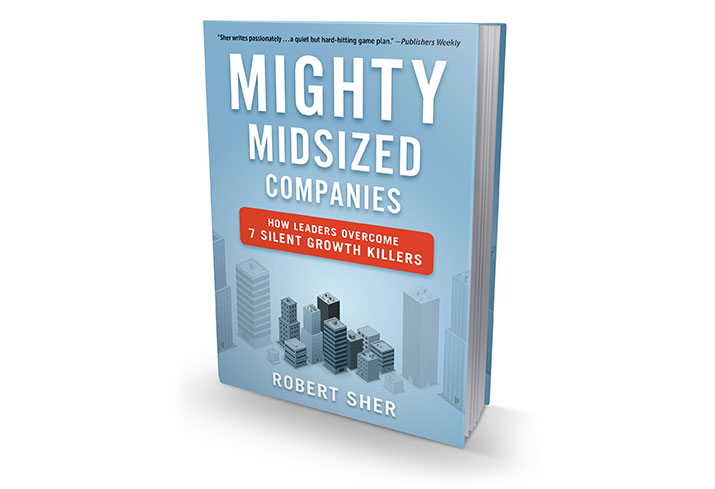
Btrax Design Company > Freshtrax > 7 Silent Growth...
7 Silent Growth Killers of Midsized Companies
Midsized companies—classified as those with revenues between $10 million and $1 billion—face a distinct set of challenges unlike those faced by their smaller and larger counterparts, especially if the company operates in more than one country. These challenges create ideal conditions for the emergence of seven silent growth killers, nasty pitfalls that drain a firm’s momentum, energy, and viability.
Harvard Business Review asked author Robert Sher to publish a seven-part, online series, based on his new book, Mighty Midsized Companies: How Leaders Overcome 7 Silent Growth Killers. The research-based book identifies the seven growth killers of midsized firms and outlines how leaders can combat them—or, better, avoid them altogether. The seven silent growth killers are:
1) Letting Time Slip-Slide Away
Time—or rather, lack of appreciation for it—is the first silent growth killer. Having many different time zones to contend with make this even more difficult. In order to overcome this killer, leaders must create a sense of urgency around deadlines by tying projects to the calendar—combining time boxing, expectations, prioritization and intermediate deadlines.
The effort to do so must be intensified when operations span borders. This creates clarity and ongoing pressure, thereby leading to greater appreciation for time and better results.
2) Strategy Tinkering at the Top
For midsized companies, tinkering with the business’s core strategy can be deadly, particularly when changes are made without proper research, planning and testing. The confusion can be far worse for global companies, and fear, uncertainty and doubt from tinkering can linger much longer.
Any changes made should be necessary, well-planned and in alignment with organizational goals. To ensure this is true, leaders should conduct strategic planning and operational planning as separate tracks and with a high level of discipline.
3) Reckless Attempts at Growth
In the effort to scale, organizations face increased risk and expense. If the attempt at growth costs too much and the revenue doesn’t match the expense, growth won’t materialize, but a cash crunch will.
To determine the optimal spending velocity, leaders must objectively assess their level of confidence in market acceptance, execution ability and forecasting ability. Growth initiatives in several markets with different cultures are at high risk for faulty assumptions & forecasts.
4) Fumbled Strategic Acquisitions
Acquisitions can be vital part of a growth strategy, but they can also derail an organization. Successful less than half of the time, acquisitions are less about the deal and the closing and more about what happens afterward: the integration process and execution of the acquisition plan. Distance between buyer and seller is a critical risk factor, so acquisitions overseas require the highest level of discipline. 
Photo by: Esther Vargas
To beat the odds against acquisition success, leaders must carefully consider four critical factors: alignment with the buyer’s core strategy; the M&A experience level of the buyer’s executives; the fit between buyer and seller as to scale, culture (both company culture and country culture) and operations; and lastly, the discipline and focus of the integration process. One US public firm in the pharmaceutical industry bought a Chinese distributor and struggled with both ethical issues and divergent motivations due to an earn-out.
5) Operational Meltdown
A rapidly growing bottom line and a rigorously lean operation can be a death sentence under the cover of success. Leaders must be able to recognize four early signs that an operational meltdown is looming. They are: an overbearing sales culture; an outdated IT or physical infrastructure; a skills shortage; and too many eggs, not enough baskets.
Long supply chains spanning continents are vulnerable to meltdown if not managed well. Outsourced functions can save money, but must be managed more intensively when they are overseas. Further, leaders should reduce the organization’s risk of an operational meltdown by creating operational resilience and gaining a firm handle on budgeting and forecasting.
6) The Liquidity Crash
Running out of cash can happen to any organization—particularly those making reckless attempts at growth and those suffering financial erosion or a shock to the system. To sidestep this growth killer, leaders must learn to manage their balance sheet, aggressively cut costs upon sensing market weakness, maintain tight bookkeeping standards, relentlessly scan critical business performance metrics and ensure owner liquidity and alignment.
Global firms can find liquidity trapped in other countries, and can find bankers unwilling to lend against collateral outside their home country.
7) Tolerating Dysfunctional Leaders
Having a strong, high-performing leadership team in place is critical to growth and to overcoming the other silent killers—or better yet, avoiding them in the first place. Organizations must not tolerate high-maintenance leaders or those who consistently underperform—regardless of their popularity.
Leadership teams that are spread across the globe have an even greater challenge in being evaluated and teaming. Diverse cultural backgrounds can add amazing value, but are more complex to manage as well. Leaders must regularly assess the strength of the leadership team, and strive to reduce the range between the lowest and highest achieving performers.
The seven growth killers as well as specific insights into how to detect and overcome the killers are explored in a seven part series on the Harvard Business Review, and in the book: Mighty Midsized Companies (Bibliomotion; September 2014).

Adapted from Mighty Midsized Companies: How Leaders Overcome 7 Silent Growth Killers (Bibliomotion; hardcover; September 2014), by Robert Sher.
 |
Robert Sher – Guest Contributor
Robert Sher is the founder of CEO to CEO and the author of Mighty Midsized Companies: How Leaders Overcome 7 Silent Growth Killers (Bibliomotion; hardcover; Sept. 16, 2014). A regular columnist on Forbes.com, Sher has worked with executive teams at more than 80 companies to improve the leadership infrastructure of midsized organizations. |
Check Out Our FREE E-Books!
Discover our FREE e-books packed with valuable research and firsthand insights from industry experts!
Dive into our collection below, and stay tuned – we’re constantly adding new titles to keep you ahead of the curve.
- Big in Japan: Global Brands Thriving in the Japanese Market, Vol. 1
- A Guide to the Promotional Seasons in Japan
- What I Wish I Knew Before Entering the Japanese Market
- 100+ Facts to Understand the Motivations Behind Japanese Behaviors
- Insights on Japan’s Changing Workstyle
- Insights into Japan’s E-Commerce and Direct to Consumer (D2C) Market







